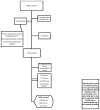Novel serum and urine markers for pediatric appendicitis
- PMID: 22221321
- PMCID: PMC3261304
- DOI: 10.1111/j.1553-2712.2011.01251.x
Novel serum and urine markers for pediatric appendicitis
Abstract
Objectives: The objective was to describe the association between two novel biomarkers, calprotectin and leucine-rich alpha glycoprotein-1 (LRG), and appendicitis in children.
Methods: This was a prospective, cross-sectional study of children 3 to 18 years old presenting to a pediatric emergency department (ED) with possible appendicitis. Blood and urine samples were assayed for calprotectin and LRG via enzyme-linked immunosorbent assay (ELISA). Final diagnosis was determined by histopathology or telephone follow-up. Biomarker levels were compared for subjects with and without appendicitis. Recursive partitioning was used to identify thresholds that predicted appendicitis.
Results: Of 176 subjects, mean (±SD) age was 11.6 (±4.0) years and 52% were male. Fifty-eight patients (34%) were diagnosed with appendicitis. Median plasma calprotectin, serum LRG, and urine LRG levels were higher in appendicitis versus nonappendicitis (p < 0.008). When stratified by perforation status, median plasma calprotectin and serum LRG levels were higher in nonperforated appendicitis versus nonappendicitis (p < 0.01). Median serum LRG, urine LRG, and plasma calprotectin levels were higher in perforated appendicitis compared to nonperforated appendicitis (p < 0.05). Urine calprotectin did not differ among groups. A serum LRG < 40,150 ng/mL, a urine LRG < 42 ng/mL, and a plasma calprotectin < 159 ng/mL, each provided a sensitivity and negative predictive value of 100% to identify children at low risk for appendicitis, but with specificities ranging from 23% to 35%. The standard white blood cell (WBC) count achieved 100% sensitivity at a higher specificity than both novel biomarkers.
Conclusions: Plasma calprotectin and serum/urine LRG are elevated in pediatric appendicitis. No individual marker performed as well as the WBC count.
© 2012 by the Society for Academic Emergency Medicine.
Conflict of interest statement
Figures
References
-
- Flum DR, Morris A, Koepsell T, Dellinger EP. Has misdiagnosis of appendicitis decreased over time? A population-based analysis. JAMA. 2001;286(14):1748–53. - PubMed
-
- Partrick DA, Janik JE, Janik JS, Bensard DD, Karrer FM. Increased CT scan utilization does not improve the diagnostic accuracy of appendicitis in children. J Pediatr Surg. 2003;38(5):659–62. - PubMed
-
- Korner H, Sondenaa K, Soreide JA, et al. Incidence of acute nonperforated and perforated appendicitis: age-specific and sex-specific analysis. World J Surg. 1997;21(3):313–7. - PubMed
-
- Pena BM, Taylor GA, Lund DP, Mandl KD. Effect of computed tomography on patient management and costs in children with suspected appendicitis. Pediatrics. 1999;104(3 Pt 1):440–6. - PubMed
Publication types
MeSH terms
Substances
Grants and funding
LinkOut - more resources
Full Text Sources
Other Literature Sources
Medical
Miscellaneous


